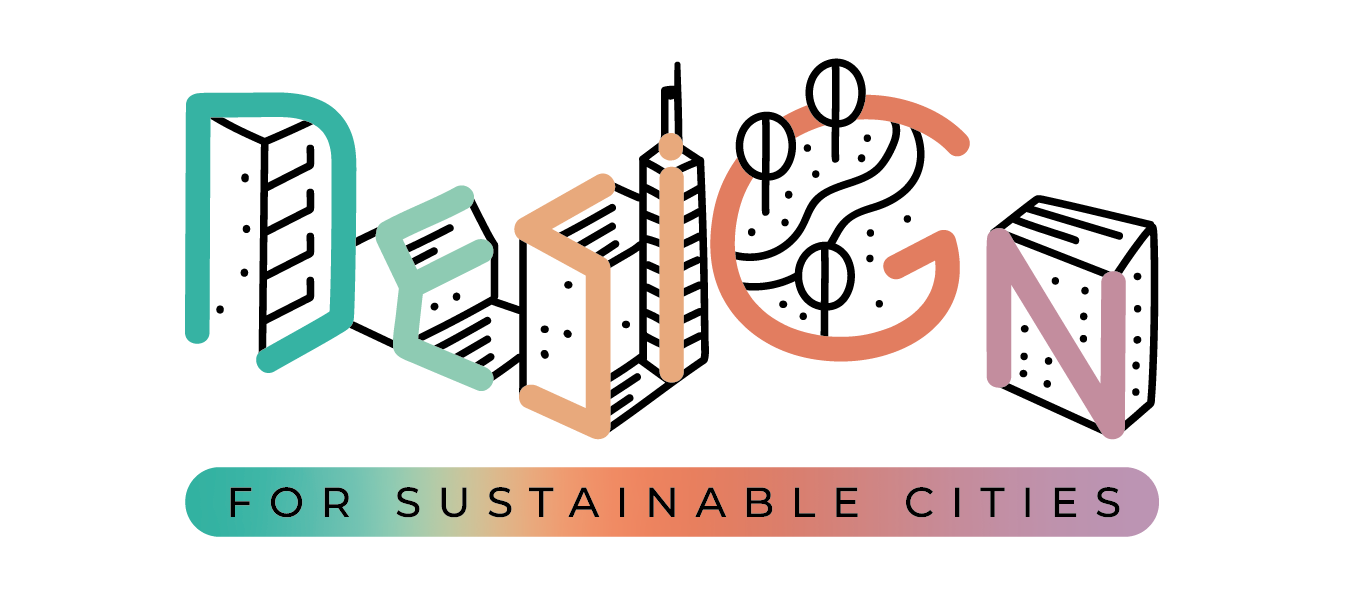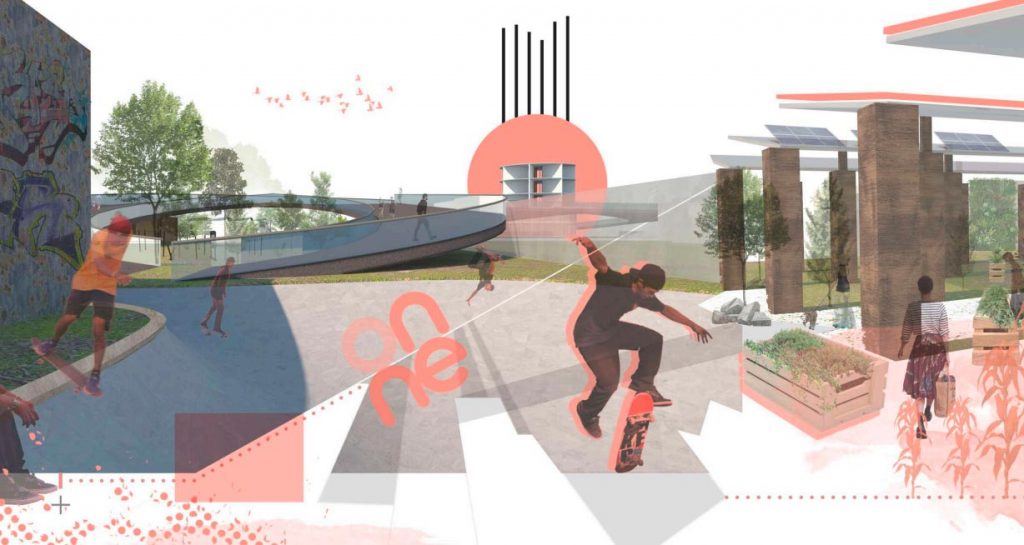“A space with walkable ranges that provides environmental, social and economic benefits as a result of the use and production of renewable energy.” – Own definition of a safe and sound city to address cities’ issues regarding the respective SDGs [zero hunger, good health & wellbeing, clean water & sanitization]. According to the three embedded categories, we narrowed down problems. 1-Environmentally: green areas deficits; carbon footprint far from approaching net zero; and not benefiting from sites’ orientations towards the sun, wind, and ad hoc resources available. These have the power to either harm or enhance the health of a community, physically and mentally. 2-Socially: informal commerce produces unregulated jobs & waste, no sanitization nor economic stability to access healthy food, unsafe pedestrian mobility, lack of public space for recreational & cultural identity development. 3-Economically: unoccupied dwellings, which lower added value & impoverish the urban image.
“The one that can make a change connecting”
Onne gets its name from the word “connection” mainly because of the connectivity and identity that we want to generate between the user and the neighborhood. Proposing a self-sustaining energy community that combines environmental, social, and economic aspects to provide health, food, renewable energy and security for the inhabitants is what sets us apart. This connection is generated through a bridge along the three sites of our case study: Barrio San Miguel.
Instead of imposing behaviors on people, through design and proposals by stepping over them (metaphorically speaking) rather than literally stepping over and inviting stakeholders to walk, ride and socialize above, on elevated designs (since ground level proposals haven’t brought successful results yet, neither improved urban image).
Onne also refers to the word “one”, because it is the first project that proposes solutions through renewable energy production systems in a city like Leon, Guanajuato. We trust this proposal may be the one that triggers a change in the mentality of architectural design and urban planning, especially in cities of Latin American countries.
Onne, is located adjacent to the Barrio de San Miguel in the city of Leon Guanajuato, Mexico. It is developed on three sites between Blvd. Torres Landa and Venustiano Carranza.
Based on our definition of what a safe and sound city is, we worked on the creation of an energy and self-sustaining community, proposing at least one power generation system in each site, and through connectivity among them via a circuit that allows universal accessibility, identity development with the community and responds to the SDGs [zero hunger, good health & wellbeing, clean water & sanitization].
The circuit in general terms, consists of a bridge completely designed for pedestrians, people with disabilities, cyclists and skaters, etc. This bridge begins its journey on the site #3 of the project and crosses Blvd. Torres Landa until it reaches site #2. The connection is achieved by means of ramps, which in turn are the ones that form the general circulation of the project. On these ramps, different activities can be carried out: walking, running, biking, skating, playing and it can even be used as a commercial corridor because, regarding the social category in our definition, an output from the site analysis was there’s a lot of informal commerce in the 1km action ratio, so we attempt to create an area where street vendors can be relocated safely and formally, consequently improving urban image.
Another output of the 1km action ratio site analysis, was an 84% deficit in green areas. Taking this into account, we propose on site #1, a green area where gym equipment that generates electrical energy when in movement was placed; even if the user isn’t going to exercise, the fact that they have to cross this pleasant green area to reach the skate park or just to hang there or to continue through the circuit in order to get to site #2 and #1 creates a unique experience that only Onne can give.
For site #2, where the bridge descends (coming from site #3), the project proposes an eco-parking lot and a five level building, which on the ground floor has commercial premises that follow the same design objective as the local commerce of the corridor. On the first level of the building there are the offices of the cooperative in charge of managing all the urban garden (located in site #1) services and the project’s energy generation systems. While the last three levels contain a wind power generation system, based on Odin Energy’s vertical axis wind generators, which are ideal for cities, because they work with light winds. In addition to the wind system, solar panels were placed on the top of the building and on the levels with turbines.
The circuit gets to site #1, the north of the project, where we proposed urban gardens along with solar panels that generate solar energy to meet the project’s energy consumption (sustainably) and to commercialize the remaining energy. A zone of commerce was also created in which the products resulting from the orchards can be marketed, which in return also responds to our categories of a safe and sound city, which are, social: that incites and generates a concern for the care of the environment; economically: because it seeks to generate monetary income by providing jobs to the families in charge of the orchards and also creates an improvement in the quality of food in the community, since the consumption of organic food is promoted and hunger in the community is eliminated. And environmentally: because it seeks to promote the use of clean energy.
It is important to mention that the architectural program of the project does not include housing, because when doing the site analysis we found that the percentage of abandoned housing in the area is 10.13% and the intention of the project is that by rehabilitating the neighborhood through the different strategies, a rehabilitation of the existing home would be generated as a consequence.
To support our “diagnosis protocol”, we focused on a case study: Barrio San Miguel- Leon, Gto; where within a 1km ratio of analysis, we discovered weaknesses associated with poor health and that the key to improve them would be to replace traditional energy sources with renewable ones.
Air quality. At peak times, air quality can be harmful to sensitive groups in León. Under this condition, it is not advised to perform outdoor activities and it is recommended to reduce car use. 61.05% of air pollutants come from mobile sources. By 2050 it’s expected a 442% population growth, so air quality will be compromised with these factors. That’s why we encourage the use of clean energy.
Wastewater/water pollution. In Leon, it is caused mainly by population growth and industrial activity. The water supply is overexploited with 48.2 million m3 per year. Only 13.3% of the Leon delegations have a wastewater treatment plant. More than 30% of the water that is extracted in León is lost in leaks. And more than 50% of the drinking water obtained is used for agriculture.
Solid waste. This sector is managed through concessions and private companies. In 2019, Leon generated 472,486 tons of solid waste with an expected increase of 22,000 tons by 2020. We propose a Solid Waste Management Plan to improve its storage, collection and transport until its final treatment. Benefits: saving energy, avoids exploitation of natural resources, reduces pollution and a more pleasant atmosphere.
Electric power. Mexico’s Energy Transition Law aims for 35% of the energy consumed in the country to be clean by 2024. In León the optimal physical and geological conditions are given for the generation of solar and wind energy. That’s why we propose a 3-level wind tower, with a system that allows generating energy with winds from 1 m/s and 576 m2 for solar panels.

